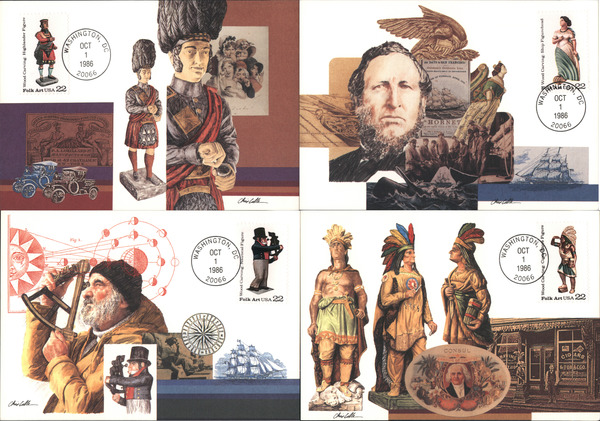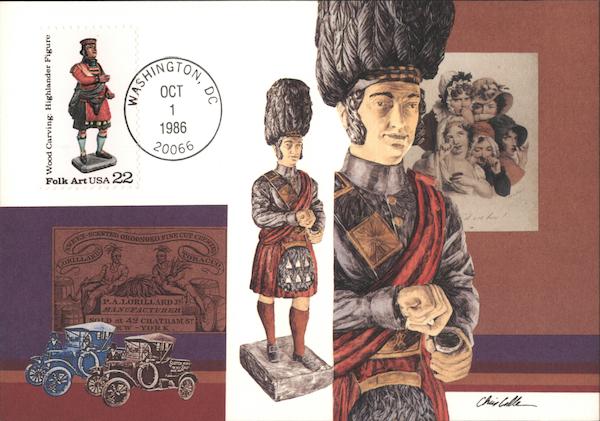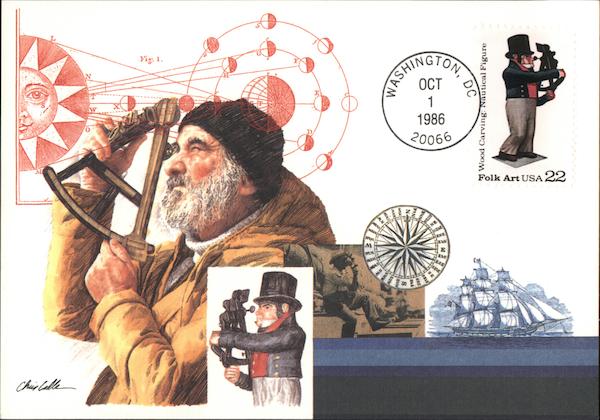Set of 4: 1986 22c USA Folk Art
Front:
ASTRINGTOR
DC
ОСТ
1986
20066
Folk Art USA 22
CHEWANE
OROONOKO FINE CU CHE
SCENTED
SWEET-S
TOBACCO
LORILLARD
P.A.LORLLARD JE
MANUF CTURER
SOLD at 42 CHATIIAM ST
EW-YU RK
SCOTCH KING
Chir lable
Wood Carving: Highlander Figure
105 DAYS to SAN FRANCISCO!
Coleman's California Line,
ILING RERELARLY AS ADVERTISED
TUESDAY,
APRIL 10th
PER OF
22
ОСТ
1986
HORNET
20066
Dew rapidiy Toadisg at Pler 15 Fa
WE
COLEMAN co,
CharCalle
Wood Carving: Ship Figurehead
WAS
DC
Fig: 1.
AN
AHINGTON
OCT
1986
20066
Folk Art USA 22
ANEIN
NE
NESE
ENE
ELN
SIM
EbS
ESE
ASEE
MSM
Chuis Lable
DC
Wood Carving: Nautical Figure
N-
MNN
ASHINGTON
ОСТ
1986
20066
Folk Art USA 22
LARSERN
CONSUL
任AYING
CIGARS
FABRICA DE TAGACOS
ΤΟΥ
&TOBACCO.
510
CIGARS
CIGARS
LORO
Cheis Lable
Wood Carving: CigaStore Figure
Back:
HIGHLANDER FIGURE
First Day of Issue: October 1, 1986
First Day City: Washington, D. C.
The use of wood carved figures for advertising in America
can be traced back to England. One of the most common
examples of this practice was the Scottish Highlander,
"Highland Laddie," and the Snuff Highlander figures
which English wood craftsmen first carved for English
tobacco shops. These figures soon became symbols for
tobacconists throughout colonial America. Most figures
were intricately detailed and carved at life-size or larger.
Typically, The Highlander would stand in the doorway
of the snuff shop with its hand extended offering a pinch
of snuff to the passerby, while holding his snuff pouch
in the other hand. The Highlander was always carved
dressed in a tartan kilt, colorful bonnet, and a sporran
fur — the traditional pouch worn at the waist by Scot
Highlanders. But, as the United States won its indepen-
dence, and settlers moved westward, the Highlander
was replaced by a more distinctively American image
– the Cigar Store Indian.
No. 86-74
1986 The Maximum Card Collection
A Division of Unicover Corporation . Cheyenne, WY 82008-0007
Original painting by Chris Calle.
--
SHIP'S FIGUREHEAD
First Day of Issue: October 1, 1986
First Issue Location: Washington, D.C.
Of all woodcrafts, those used in shipbuilding rank among
the oldest arts — and certainly one of the most vital to
progress in America from colonial days onward. Some
of the finest examples of a shipbuilder's artistic expres-
sion could be found in the figureheads which graced the
bows of ships. The figureheads these craftsmen carved
performed no useful function, yet rarely was a ship
lacking one. The tradition of ship's figureheads dates
back to the early Mediterranean explorers, the Phoeni-
cians. The custom of creating and placing figureheads
below the bowsprit was continued by shipbuilders in the
New World, and after the Revolution, in the new United
States. Early American figurehead carvings featured
slightly larger than life-sized animals and women, but
as the United States became a proud, independent na-
tion, heroes of the Revolution and American folk heroes
were also skillfully carved.
No. 86-75
©1986 The Maximum Card Collection
A Division of Unicover Corporation . Cheyenne, WY 82008-0007
Original painting by Chris Calle.
NAUTICAL FIGURE
First Day of Issue: October 1, 1986
First Day City: Washington, D. C.
A favorite form of advertising in the nineteenth century,
wood carved figures were especially popular with naut-
ical equipment suppliers. Outfitters, instrument makers,
and sail makers all used carved figures to demonstrate
and promote their wares to seamen and captains of
various nations and languages. Many of these figures
were carved by the sailors themselves. To relieve the
tedium of most voyages the sailors used the jack-knives
they carried to whittle. Many patiently worked exotic
woods — like mahogany, teak and sandalwood, gar-
nered from the various ports of call — into exquisite
figures. “The Navigator" featured on this Maximum Card
was carved for the shop of James Fales, a nautical instru-
ment maker from New Bedford, Massachusetts — a
major whaling port. The figure demonstrates a navigator
using a sextant to measure angular distances.
No. 86-76
©1986 The Maximum Card Collection
A Division of Unicover Corporation • Cheyenne, WY 82008-0007
Original painting by Chris Calle.
CIGAR SHOP INDIAN
First Day of Issue: October 1, 1986
First Day City: Washington, D. C.
The artistry of America's folk art vividly evokes life in
the small towns and homesteads of the eighteenth and
nineteenth century. Usually using nothing more than a
knife or a piece of broken glass, the wood carving artist
transformed an odd piece of pine or cedar into a unique
work of art. Often the wood carver would work for
storekeepers who wanted wooden figures to place out-
side their shops, advertising their wares. The most dis-
tinctively American form of such figure carvings is the
cigar store figures created between 1850 and 1885. Cigar
Store Indians carried a message even the most unedu-
cated person could understand: “tobacco sold here."
They welcomed smokers by offering a bunch of cigars
in one hand and a plug of tobacco in the other. Some
were carved in simple relief; others featured ornate de-
signs and expressions which gave the Indians an elegant
yet friendly air.
No. 86-77
©1986 The Maximum Card Collection
A Division of Unicover Corporation . Cheyenne, WY 82008-0007
Original painting by Chris Calle.










